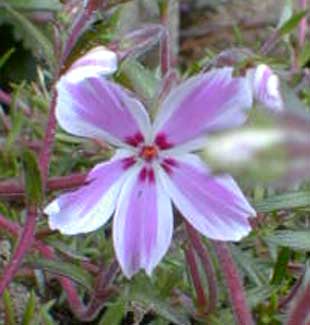
'Candy Stripe'
Creeping Phlox; aka,
Moss Phlox, Dwarf Phlox,
or Moss Pink
"There amid the tinted bowers,
Raptur'd with the opiate spell
Of the grasses, ferns & flowers,
Poppy, Phlox & Pimpernel,
Long I lay, entranc'd & dreaming,
Pleas'd with Nature's bounteous store,
Till I mark'd the shaded gleaming
Of the sky, & yearn'd for more."
-H. P. Lovecraft
(1890-1937)
(1890-1937)
Phlox subulata 'Candy Stripe' prefers full sun to bloom its best, but will also do well in partial shade. It wants well-draining soil, & can do nicely in somewhat droughty conditions, so can be a good edging plant for a difficult location. By contrast it is not tolerant of too much dampness, & can be vulnerable during winter rains if soil is not swiftly draining.
Cold-hardy to zone 4 (or to zone 3 with protection), creeping phloxes are not especially heat-hardy, & are best for temperate zones. It is only two to six inches tall, & easily covers a one-foot or eighteen-inch spread, & over time a single plant can spread to three feet. It will cascade over a curb or down a short wall or from a hanging basket. Ours is on at the top ledge of the stone wall of a raised bed.
Its primary bloom period is April & May, with delicate needle-thin foliage the rest of the year. After it has finished flowering, or no later than mid-August, it can do with a mild shearing to stimulate new growth that will remain fairly fresh through the winter, though if it does get scruffy it can do with another sheering before spring.
When grown with early-flowering spring bulbs, it provides a pleasing groundcover matting for the rest of the year, after the bulbs are no longer flowering; yet it is itself short enough at only two to six inches height that it will not interfer with bulb performance.
Moss phloxes grow native to the northeast United States, with three subspecies & a great variety of forms that have been very helpful in developing garden cultivars.
See also:
Phlox subulata 'Red Wings'
Phlox subulata 'Red Wings'